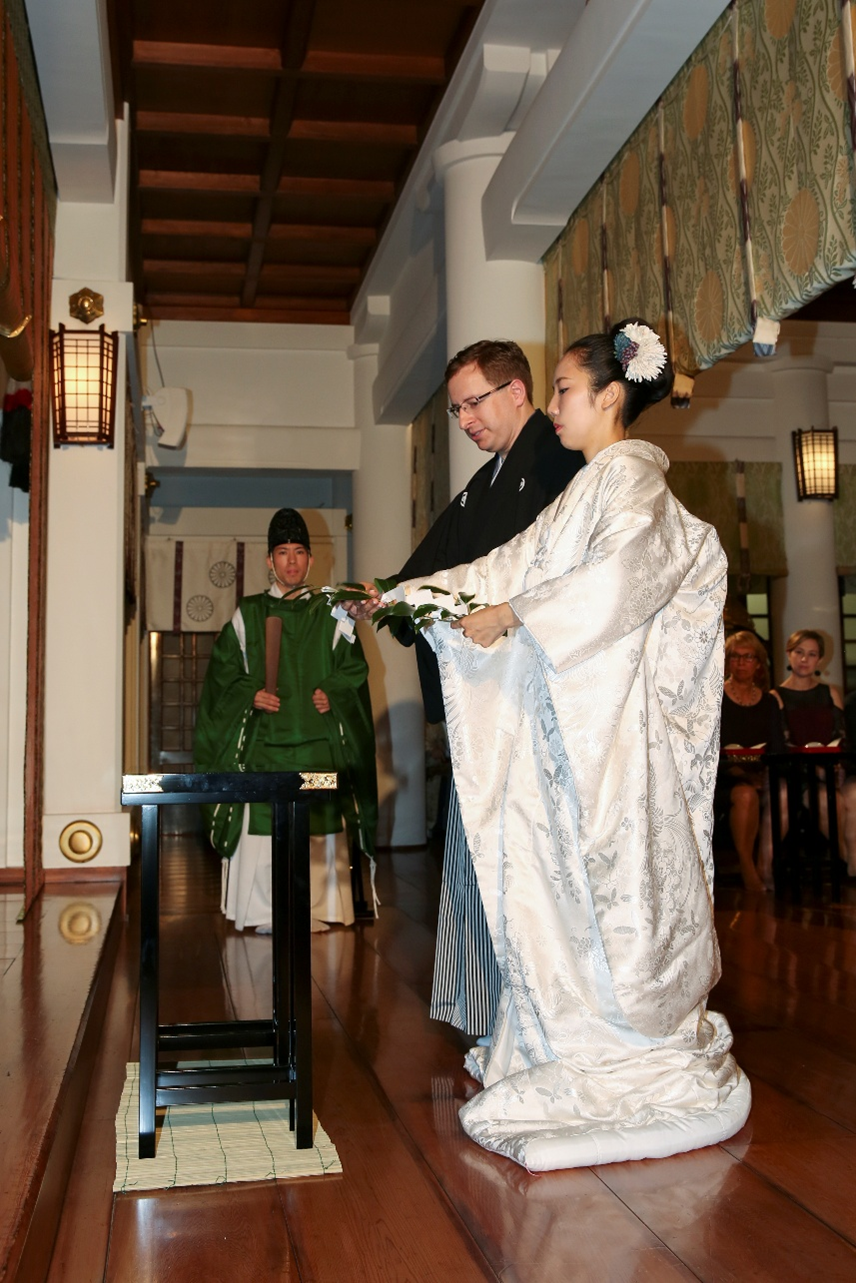November 2025
Cultural Article
My Japanese Shinto-Style Wedding
By Tomomi Dodd
As I write this journal, I’m reminded, as I do every year around this time, of my wedding in Japan in October 2017. My American fiancé at the time and I decided to hold a wedding in Japan, and specifically a traditional Shinto-style wedding at a shrine. We came to the decision as we had wanted to show respect to Japanese culture and embrace it. With plans to move to America in the near future, we also knew we wanted to host the wedding in Japan so that mutual friends, which we had both met while attending the same college in Tokyo, would be able to attend. Though we had heavy rain due to typhoon on the wedding day, I felt that it turned out a memorable and beautiful event.
A Shinto wedding is a traditional Japanese ceremony held at a shrine or at a temple. It means marriage before the kami (God). I will introduce some of the main steps we performed during our wedding. Please note that every wedding venue is different and may have different steps.
First of all, we walked down the isle outside of the shrine led by two Mikos. Miko are young priestesses who serves at a Shinto shrine. As we were entering the wedding ceremony stage, a giant drum was pounding.

(Walking to the wedding ceremony venue led by two Mikos.)

(Beginning of the wedding ceremony)
Then we did an exchanging of Sake - San San Kudo. As the bride and groom, we took turns sipping three times from cups of three sizes: small, medium and large. (The first two times, the cup is raised to one’s lips. The sake is only drunk on the third sip.) This act represents purification.

(San-san-kudo)
Next, we read a wedding vow. Here is what we read in Japanese.
Watakushidomo Ryoumei wa Honjitsu Yuishoaru Sanno Hiejinja ni Oite Kekkon Itashimasu. Watakushidomo wa Sougo no Ishi wo Sonchou shi Rikai ni Tsutomete Mairimashita ga, Kongo Yoriissou Katai Shinrai to Aijou nioite Ningen toshite no Musubitsuki wo Takamete Yukukoto wo Koko ni Chikaimasu.
(English translation: Today we are getting married at Hie Shrine. We promise to continue to strengthen our bond, trust, and love while maintaining mutual respect. )
In the end, we presented Sakaki branches. Sakaki is an evergreen tree native to Japan, and it is considered a bridge between the divine and humanity. As the bride and groom, we received the Sakaki branches and placed them at the altar. Then we bowed twice and clapped twice. Next, our dads, as the fathers of the groom and bride respectively, received Sakaki and placed them at the altar. They in turn bowed twice and clapped twice. Following this was a dance performance by the Mikos.

(Bride and Groom placing Sakaki branches)

(Fathers of bride and groom placing Sakaki branches)

(Dance performance by Mikos)
Though all the preparations for the wedding ceremony and reception were chaotic and stressful, I am still very happy that we had a Japanese style Shinto wedding and my husband’s side of family experienced some of Japanese culture and met my family and friends. I deeply appreciate that they came to Japan all the way from America for us. I cannot forget what my brother-in-law told me later when he said that it was one of the coolest experiences he has had.
Just for your reference, we had a wedding at Hie Akasaka Shrine in Tokyo. It is a very beautiful Shinto shrine distinct in its vermilion color, and has a very long and deep history as it was built in the year 1478. It is worth visiting just to see the shrine. You might be able to see some cute children in Kimono for children’s ritual (Shichi-go-san), especially if you go in October or November.

(The bride and groom in front of the Hie Shrine.)
References:
Hie-jinja Shrine(Spot)|Chiyoda Tourism Association
Embracing the Beauty of Japanese Shinto Weddings | Japan Up Close
.png)